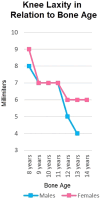Creation and validation of a treatment algorithm for skeletally immature patients with acute anterior cruciate ligament injury based on MRI and patient characteristics
- PMID: 40766807
- PMCID: PMC12322690
- DOI: 10.1002/jeo2.70280
Creation and validation of a treatment algorithm for skeletally immature patients with acute anterior cruciate ligament injury based on MRI and patient characteristics
Abstract
Purpose: This study aimed to develop and validate a clinical decision-making algorithm, the 'Best ACL-treatment Based on the Years of the Knee' (BABY-Knee) Algorithm, for treating acute anterior cruciate ligament (ACL) injuries in skeletally immature patients. The algorithm integrates magnetic resonance imaging (MRI) findings and patient-specific characteristics to differentiate cases suitable for conservative management from those requiring surgical intervention.
Methods: A prospective cohort of 75 skeletally immature patients (mean age: 13.9 ± 2.2 years) diagnosed with ACL rupture at a single institution between February 2022 and October 2024 was evaluated. Patients were categorized as surgical or non-surgical candidates based on the BABY-Knee Algorithm, which incorporates six weighted criteria: MRI-detected meniscal tears, lateral tibiofemoral bone bruises, skeletal age, injury mechanism and rotatory laxity. Outcomes of initial management were retrospectively analyzed for algorithm validation.
Results: Of the 75 patients, 55 (73.3%) underwent surgical reconstruction, while 20 (26.7%) were managed conservatively. Conservative treatment failed in 12 cases (60%), necessitating surgical intervention. Retrospective application of the algorithm yielded a positive predictive value of 91.7% for identifying surgical candidates and a negative predictive value of 87.5% for successful conservative treatment.
Conclusion: The BABY-Knee Algorithm demonstrated high reliability in guiding treatment decisions for skeletally immature patients with acute ACL injuries, predicting outcomes of conservative treatment in nearly 90% of cases. Further studies are required to confirm its applicability in additional prospective case series.
Level of evidence: Level IV, case series.
Keywords: ACL; MRI; algorithm; paediatric; physeal sparing; skeletally immature.
© 2025 The Author(s). Journal of Experimental Orthopaedics published by John Wiley & Sons Ltd on behalf of European Society of Sports Traumatology, Knee Surgery and Arthroscopy.
Conflict of interest statement
Alberto Grassi: not‐paid consultant for Smith & Nephew. Kyle Borque: paid consultant for Mitek and Xiros Inc.; receives research support from CONMED Linvatec and Xiros Inc. Stefano Zaffagnini: paid consultant for De Puy Synthes and Smith & Nephew; Board member of European Society of Sports Traumatology Knee Surgery and Arthroscopy (ESSKA) and International Society of Arthroscopy, Knee Surgery, and Orthopaedic Sports Medicine (ISAKOS); Editor in Chief of Journal of Experimental Orthopaedics (JEO). The remaining authors declare no conflicts of interest.
Figures
References
-
- Astur DC, Cachoeira CM, da Silva Vieira T, Debieux P, Kaleka CC, Cohen M. Increased incidence of anterior cruciate ligament revision surgery in paediatric verses adult population. Knee Surg Sports Traumatol Arthrosc. 2018;26(5):1362–1366. - PubMed
-
- Baessler AM, Buchman JM, Witte DA, Spence DD, Throckmorton TW, Brolin TJ, et al. Skeletally immature patients with classic anterior cruciate ligament bone bruise patterns have a higher likelihood of having an intact anterior cruciate ligament compared with skeletally mature patients. J Pediatr Orthop. 2023;43(1):13–17. - PubMed
-
- Baxter MP. Assessment of normal pediatric knee ligament laxity using the genucom. J Pediatr Orthop. 1988;8(5):546–550. - PubMed
-
- Beck NA, Lawrence JTR, Nordin JD, DeFor TA, Tompkins M. ACL tears in school‐aged children and adolescents over 20 years. Pediatrics. 2017;139(3):e20161877. - PubMed
LinkOut - more resources
Full Text Sources
Research Materials



